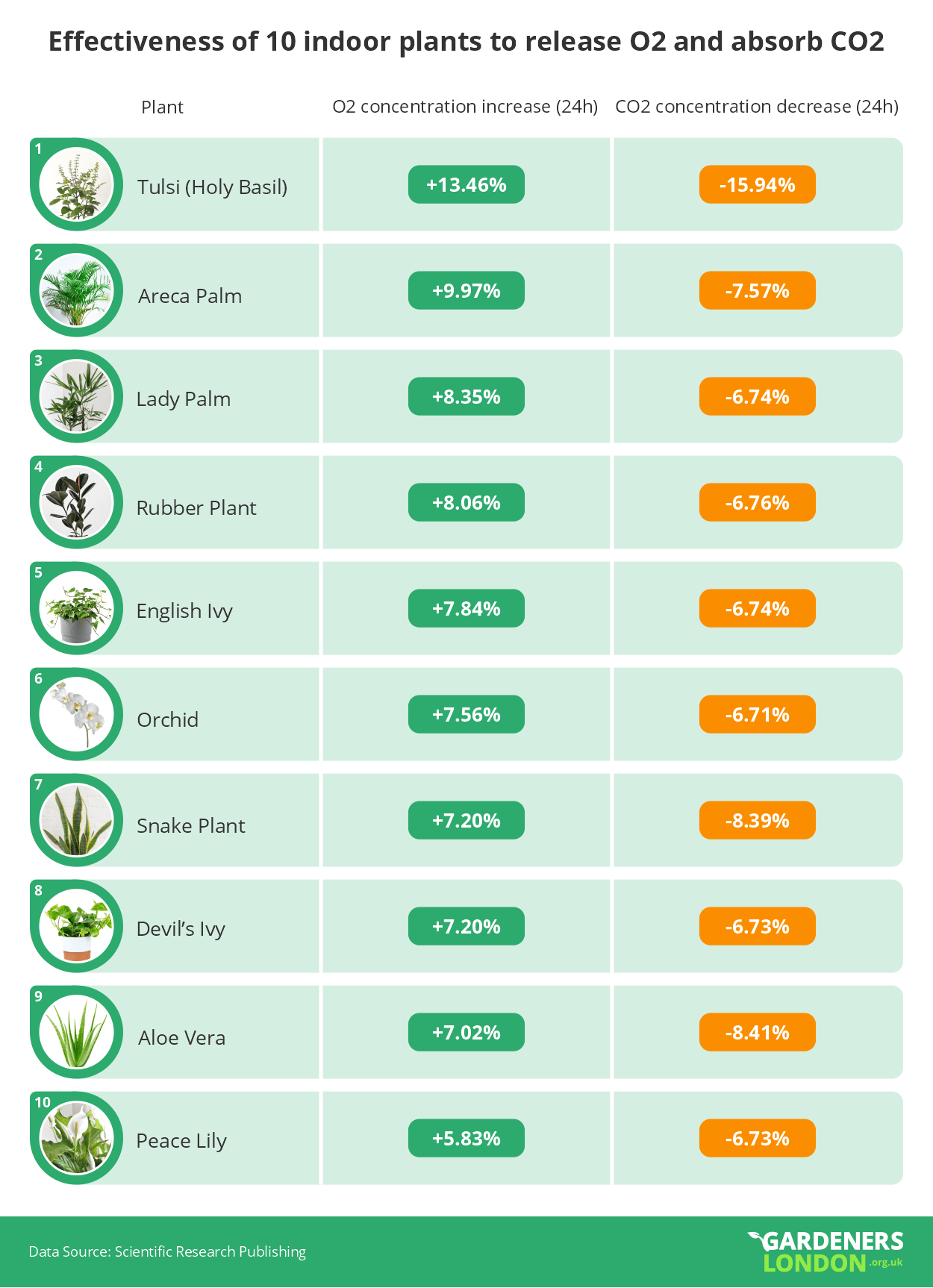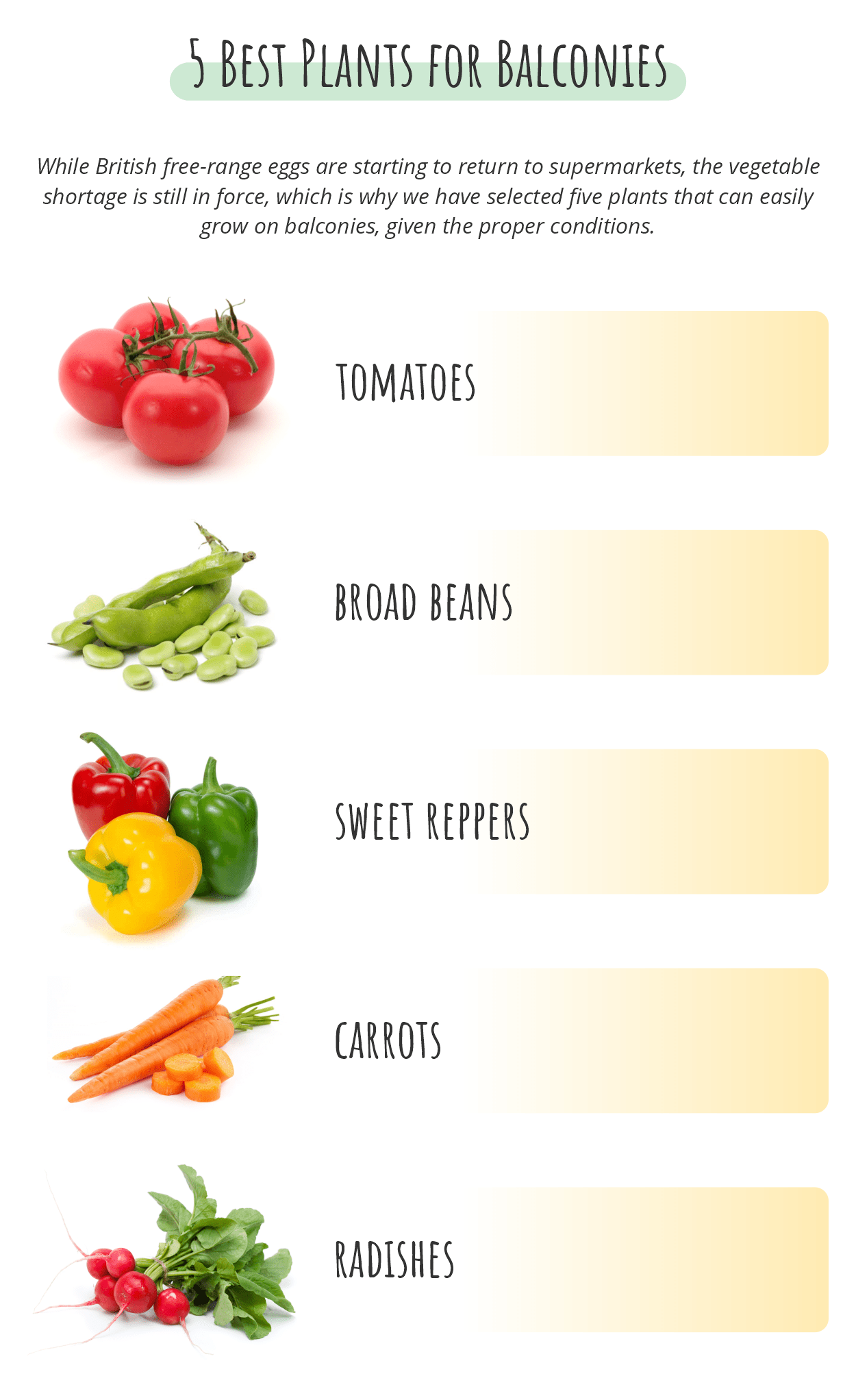Indoor plants are an invaluable asset to the aesthetics of any home. Besides adding beauty, many species offer powerful health benefits. Eager to find out which are the best performers for improving the air quality of our homes, the team at GardenersLondon turned to information in a detailed scientific publication. Thus, we were able to rank ten oxygen-producing CO2-absorbing indoor plants which can be used as powerful allies for healthier living. Additionally, we consulted a local expert with 20 years of hands-on experience in horticulture.
Methodology
The study we based our calculations on is titled The Impact Study of Houseplants in Purification of Environment Using Wireless Sensor Network. In it the team of researchers put the studied plants in a closed controlled environmental chamber and using a Wireless Sensor Network they measured Oxygen (O2) and Carbon dioxide (CO2) concentrations at the start and after a 400 minute period.
With this in mind, our team extrapolated how much CO2 each of the ten plants here below can absorb in 24 hours, and by what percentage each plant would increase the O2 concentration in the enclosure within the same period. We ranked the plants based on this criteria to identify the ones that would most positively affect the air quality in your home.
The Findings

Ten Indoor Plants Ranked by O2 Release
1. Tulsi (Holy Basil)
If you are fond of the colour purple, you will be pleased to find that the tulsi, or holy basil, as it is known in the UK, takes the first spot in our ranking. Our calculations show that within 24 hours, the herb can lead to a 13.46% increase of oxygen in the air and absorb around 68.4 ppm of carbon dioxide. Holy basil also happens to make for an excellent cup of tea, and it can be used in cooking or even as an effective mosquito repellent.
2. Areca Palm
Areca palms are a great option for those who adore the tropics and tropical vegetation, in particular. Native to Madagascar, the areca palm is a plant that enjoys a warm environment indoors. It is not a demanding plant, and so long as you water your areca palm regularly, it can grow to over two metres in height. Our data shows that for 24 hours, an areca palm can increase the oxygen concentration by nearly 10%. It is also one of the top plants in terms of CO2 absorption, averaging out at 32.40 ppm per day.
3. Lady Palm
Pet owners will find lady palms to be excellent to care for at home, seeing as the plant is non-toxic. Moreover, lady palms are resilient, low-maintenance, and absolutely gorgeous to boot. When it comes to the concentration of oxygen in the air, this palm species is able to release enough oxygen within 24 hours for a positive difference of 8.35% to be distinguished. The decrease in CO2, on the other hand, can reach 28.80 ppm. The lady palm is also a fantastic air purifier for various toxins, as showcased in NASA’s ‘Interior Landscape Plants for Indoor Air Pollution Abatement’ study.
4. Rubber Plant
Succulents typically make for charming indoor plants, and the rubber plant is no exception. What is more, it is fairly forgiving and thus perfect for novice plant enthusiasts. Our calculations convey that an oxygen level increase of 8.06% per 24 hours is within the capabilities of this plant. It is also able to absorb enough carbon dioxide for a decrease of 28.80 ppm to be observed. Interestingly, the rubber plant can be used to produce rubber when left to grow into a tree in its natural habitat.
5. English Ivy
The English ivy’s beautiful leaf shape and lengthy stems have prompted many home gardeners to grow their English ivies in hanging planters, with great success. Apart from being a looker, this trailing plant is also great at purifying the air, according to the study by NASA mentioned earlier. In addition, we estimated that around 28.80 ppm of CO2 can be absorbed by the plant within 24 hours. Our calculations also show that an English ivy can contribute to an oxygen level increase of 7.84% within the same timeframe.
6. Orchid
Although it is a common misconception that orchids are difficult to care for, they are anything but. These stunning indoor flowers tend to bloom once a year, and they are fairly forgiving, regardless of whether you go for the UK’s most beloved moth orchid or other popular variants like the dendrobium or vanda orchids. A 7.56% rise in the concentration of oxygen in the air is what an orchid can achieve for 24 hours. As for carbon dioxide, an orchid plant may lead to a 28.80 ppm decrease in CO2.
7. Snake Plant
Snake plants are perfect for beginner gardeners. These succulents do not require too much care, especially in terms of water; they only need to be watered when their soil is fully dry. As for CO2 absorption, snake plants share the second spot with the aloe vera plant – 36.00 ppm per 24 hours. A snake plant will also succeed in raising the concentration of oxygen in the air by 7.20%, again within one day. This is yet another plant that performed well in NASA’s air purification study, where it was listed as the ‘Mother in law’s tongue’.
8. Devil’s Ivy
The devil’s ivy is popular worldwide, and it has quite a lot of fans in the UK as well. Its leaves are often decorated with yellow spots even when healthy, which is why this plant is also known as the golden pothos. The devil’s ivy is able to release enough oxygen in the air for an increase of 7.20% to be felt within 24 hours. Simultaneously, the golden pothos plant can reduce CO2 levels by 28.80 ppm.
9. Aloe Vera
From its usage in medicine and food to serving as a wonderful house plant, aloe vera has plenty of benefits. In NASA’s air purification report, this plant, along with the peace lily, the devil’s ivy, and others, was shown to effectively purify the air of toxins like benzene and TCE. As for its performance when it comes to CO2, our estimations point towards aloe vera being fantastic at decreasing the levels of carbon dioxide in the air – 36.00 ppm every 24 hours. The study also points at a respectable increase of 7.02% in oxygen levels.
10. Peace Lily
The peace lily is a plant of Colombian and Venezuelan origin. It is suitable for practically any plant lover, even those who are new to plant parenting, since keeping one’s peace lily happy and thriving is a snap. It also goes without saying that peace lilies are beyond lovely when in bloom. They will also improve the air quality at home, as our calculations led us to the conclusion that they can absorb 28.80 ppm of CO2 per day. We also estimated that the O2 concentration can rise by 5.83% thanks to this plant.
Conclusion
“Besides being a treat to the eyes, house plants carry a host of health benefits, including improving indoor air quality to a great extent.” – comments Niki Strupnenski, local expert in gardening.
Our top ten listing gives plant enthusiasts an idea of the best performers in relation to CO2 absorption and O2 release, backed by scientific data, with Tulsi, also known as Holy Basil, being at the forefront.
Raw Data
| O2 Concentration (%) | CO2 Concentration (ppm) | ||||||
|---|---|---|---|---|---|---|---|
| Plant | T = 0 sec | T = 400 min | Extrapolated T = 24h | T = 0 min | T = 400 min | Extrapolated T = 24h | Change % (24h) |
| Tulsi | 18.56% | 22.3% | 32.02% | 429 | 410 | 360.6 | -15.94% |
| Aloevera | 19.12% | 21.07% | 26.14% | 428 | 418 | 392 | -8.41% |
| Peace Lily | 19% | 20.62% | 24.83% | 428 | 420 | 399.2 | -6.73% |
| Devils Ivy | 19% | 21% | 26.20% | 428 | 420 | 399.2 | -6.73% |
| Snake Plant | 19% | 21% | 26.20% | 429 | 419 | 393 | -8.39% |
| Orchids | 19% | 21.1% | 26.56% | 429 | 421 | 400.2 | -6.71% |
| Lady Palm | 19% | 21.32% | 27.35% | 427 | 419 | 398.2 | -6.74% |
| Rubber Plant | 19% | 21.24% | 27.06% | 426 | 418 | 397.2 | -6.76% |
| English Ivy | 19% | 21.18% | 26.85% | 427 | 419 | 398.2 | -6.74% |
| Areca Palm | 18.56% | 21.33% | 28.53% | 428 | 419 | 395.6 | -7.57% |

